EMPOWERING PEOPLE OF ALL AGES
Helping kids build lifelong healthy habits with Sonicare

2015 · Smashing Ideas · UX Architect
The Philips Sonicare team reached out to Smashing Ideas with a challenge: create a companion app for the first Sonicare toothbrush designed specifically for kids that was so appealing, so engaging, that kids would willingly want to brush their teeth, all while learning proper technique and building healthy habits for a lifetime.
- Defined the UX workflow and interaction model for the app; partnered with the super-talented Jessica Barnes on the design
- Worked with Sonicare med-techs to define the steps-to-mastery training model for both the app and the toothbrush firmware
- A fun and rewarding (and award-winning) brushing experience that's both FDA and COPPA compliant





CHALLENGE ACCEPTED
We started with identifying what would truly motivate our audience, which we unearthed through several rounds of contextual interviews in participants’ homes, early prototypes and concept tests, real-time data analytics, and even visits to numerous dental offices, to ensure professional feedback was properly incorporated.
This led to a very powerful insight:
while most kids turn brushing into a battle, they don’t actually dislike it.
In fact, the feeling of a clean mouth is extremely motivating to them. They simply don’t like to stop what they are doing, or don’t want to do what follows brushing teeth (going to bed, for example), so it becomes a stall tactic.
Making it fun for kids was the obvious goal, but we also knew that the app experience needed to be more than just a glorified timer or meaningless game.

TAPPING INTO KIDS' NURTURING NATURE
We needed kids to feel compelled to brush on their own, while still providing significant (but not heavy-handed) education around how and why to brush. Because of Jessica Barnes' vast experience and deep knowledge of designing digital experiences for kids, it didn't take long for us to formulate a concept.
Jessica created the central character for the app experience — originally named Smiggle, but changed to Sparkly due to trademarking challenges — a cute little furball in desperate need of brushing help.
Sparkly was designed to trigger care and nurturing impulses in kids, improving customer motivation to brush while sparking a strong emotional connection with the character. Because of Sparkly’s tiny arms, the only way to help him is to have kids follow along with the guidance on the mobile app screen twice a day.
The app showcases the desired movement of the toothbrush, providing real-time coaching for proper technique (informed by the input from by dental professionals). When they finish, kids receive a present for their Sparkly. This variable reward completes the habit-loop when they finish a full 2 minutes of brushing and triggers the desire to return again.

INTEGRATING HABIT-LOOPS + STEPS-TO-MASTERY
The bulk of my effort for this project was spent working with the Sonicare SMEs on defining the habit-loops and a steps-to-mastery coaching model, and determining how to integrate those into both the app experience and the connected toothbrush firmware.
In parallel, I had to ensure that whatever claims were made regarding the toothbrush's capability for fostering brushing habits and improving oral health in kids were defensible.
Sonicare for Kids is considered an FDA-regulated medical device, so clinical claims needed strong supporting evidence that the companion app would add meaningful value and help deliver on those claims.
I worked with the Sonicare team to draft a robust research plan, including per-user analytics, to provide the proof and traceability for the marketing claims.

This visualization represents the proposed daily usage cycle for the Steps-to-Mastery engagement model, and the cadence of associated app:user communications – known colloquially as a habit loop.

This habit loop is segmented into activity sessions, and captures a typical user engagement scenario for each — including how users would interact with the app during each session.
Each trigger is treated as a potential touchpoint – that is, the app may or may not provide a trigger based upon the user’s previous behavior in the form of a reminder, a quiz, an encouragement, etc. The frequency and density of triggers will be evaluated during testing and adjusted accordingly to avoid the “nag factor” for users. Collectively, the trigger touchpoints will be crafted and coordinated to help motivate the user to undertake the most appropriate targeted action.
Trigger touchpoints that fall outside the activity sessions are most typically push notifications, as the expectation is that the user will not be interacting with the app directly during these time windows.
The intent of these notifications is to
provide a cadence of gentle encouragement to the user to return and complete the lesson or program — and even once the lesson or program is done, to encourage the user to maintain good habits.
This approach taps directly into combating the “forgetting curve” through memory-strength training.
While the focus of this habit loop is on the AM and PM sessions, we wanted to honor variances in users’ daily routines beyond the typical or recommended. Hence, the inclusion of an optional lunchtime session which tracks progress in-app but does not do any active coaching.
Through a properly-tuned experience, we will apply the principles of Performances of Understanding – having the user put new learning immediately into practice, and asking the user to demonstrate their understanding in some measurable way – that will strengthen a user’s ability to learn and retain optimal habits, and thus encourage a long-term investment in their own health.
This visualization represents the overall “steps to mastery” coaching model for Sonicare for Kids (IoT device + mobile app), including the recommended cadence and density of communication delivered to the user.

Although habit-training goals occur in sequence from the user’s perspective, performance data is captured by the device and app for all goals from day-one. This enables the user to “test-out” of a goal if they have met the lesson criteria ahead of time.
If the user falls below a goal’s accuracy threshold, the app will provide reminders. If the user’s performance remains below the goal’s threshold for three (3) sessions, the app will schedule a refresher course.
Once all habit-training goals are complete, the app will transition to steps-to-mastery goals.

In-app and email-based support messages complement active guidance, encouraging the user to return to the app and progress through the goals.
While the following visualization is intended to be representative of a “typical” engagement scenario, the individual user’s mileage may vary. It is entirely possible for a user to complete each habit-training goal in as few as 3.5 days (7 sessions).

ACCELERATING TIME-to-value
While the Smashing Ideas team’s focus was squarely on the quality of the product experience, we also knew that Sonicare’s Marketing team had a bit of an uphill battle when it came to convincing kids (and parents) to purchase and use.
- Anyone who has kids knows/remembers those twice-daily brushing battles.
- Many kids refuse to do non-preferred tasks without some sort of incentive.
- Habits take anywhere from 28 to 60 days to establish.
- Many parents (at the time) lacked an understanding of Sonicare’s benefits.
- Parents were also skeptical of paying 10x for a “fancy toothbrush” when they “grew up using a basic toothbrush and their teeth are just fine”.
Partnering with a member of our Strategy team, I helped the Sonicare team identify the key value-propositions and feature highlights that would both educate parents and motivate kids.
We worked with Sonicare to define a
differentiated GTM strategy, as the market for children's toothbrushes is competitive but this would be the first ultrasonic toothbrush designed and engineered exclusively for kids. However, we also knew that Price Discrimination was a core decision motivator for parents, so we sought out ways to offset that cognitive friction point:
- The app would be free, forever.
- No in-app purchases — all in-app rewards earned by using the app regularly.
- Using bite-size (no pun intended) value-propositions and demos to educate parents (who aren’t already Sonicare users themselves) on why Sonicare technology is better for their kids’ oral health.
- Partnering with dental professionals to spread awareness and engagement — and generate buzz by providing a limited supply of toothbrushes they can give to their patients for free.
- Obtaining reviews from Consumer Reports, NerdWallet, and other well-regarded review entities to boost credibility.
- Pivoting kids’ mindset of the activity itself through a “we don’t brush, we fight bacteria bugs” media campaign, in an effort to reduce the frequency and intensity of “brushing battles” in the household.

Time-to-value was also a key consideration. For parents, it was relatively straightforward — they’re paying $30-40 dollars for a “fancy toothbrush” and they want to get their money’s worth — and the methods above addressed that. For kids, however, the concept of “value” was more qualitative — they value fun experiences.
Thanks to Jessica and the team, the app experience was overflowing with fun — from the animations, to the voiceovers and sound effects that the team had way too much fun recording, to the rewards for their Sparkly and the hidden easter eggs. And the parent dashboard allowed parents to monitor their kids’ progress and consistency.
We also did extensive experience mapping with families to understand routines and rituals in a typical household, as well as capturing sentiments from kids and parents. We heard from kids that just brushing with their Smiggle got boring after a while and they wanted to be able to play with him/her/it. But we heard from parents that screens were a constant point of friction in the house and they were concerned that giving kids the option of "free play" with their Smiggle would disrupt the delicate balance and tight timelines of morning and evening routines.
"It's great that [the Sonicare for Kids app] is helping motivate my kids to brush better, but if this thing in any way makes it harder for me to get my kids out the door to school or in bed on time, it's gone."
Research participant, parent of two
To address this potential point of abandonment, Jessica and I enabled the parent to set custom "time windows" for up to three (3) brushing routines per day — during these windows the child's Smiggle would be active, but outside those time windows the child would get a cute message from their Smiggle
"Sorry, I'm napping right now, but should be awake around 6:00 tonight. Let's play then, OK?"

As the UX Architect, it was my responsibility to ensure that the entire customer experience — from product awareness, to purchase consideration, to onboarding, to regular use — bridged the gap between the customers’ perceived value and the actual value they experienced:
- No kid sign-up/registration needed — not only did this save us weeks of roadmap time by not having to create COPPA-compliant registrations and data collection protocols for minors, but it allowed kid users to dive into the experience immediately.
- Seamless pairing of toothbrush to mobile device — we worked with Sonicare’s firmware team to tweak the pairing process of the on-board Bluetooth LE chip.
- Simple, in-app warranty registration for parents — by utilizing the on-device camera, a combo of OCR and barcode reading, and the option to register with a Google or Apple ID, we streamlined the Philips registration workflow from 8 steps, down to three (and almost no typing needed).
- Kids can still use the app with a manual toothbrush — this one was a bit contentious, but I used a quick A/B test to show the clients that:
- 100% of the users blocked from using the app until they paired their Sonicare for Kids toothbrush (which they did not have) promptly deleted the app.
- 56% of the users allowed to use the app with a manual toothbrush continued to use the app for an average of 11 days thereafter.
The collective result of these friction-reducing efforts was that kids were more likely to engage with the app, regardless of which toothbrush they owned, the app served as a sales channel in its own right by showing parents value on day-one and educating them on the increased value of purchasing a Sonicare for their kids, and prioritizing ease-of-use throughout the customer experience facilitated long-term customer engagement.
It was a device that accomplished the inconceivable: It made oral hygiene so fun that kids want to stay on top of it.